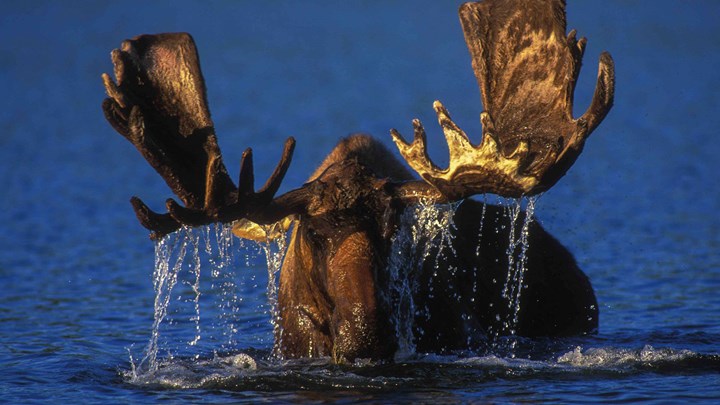
by Cody McLaughlin - Thursday, June 15, 2023

A moose in Alaska has tested positive for rabies, marking the first recorded case of a rabid moose in Alaska and all of North America.
According to a statement released on June 7 by the Alaska Department of Fish and Game (ADFG), department staff received reports the morning of June 2 of an aggressive moose in the area of Nome that appeared to be “unbalanced, stumbling, drooling profusely and had bare patches of skin.” Shortly after the reports suggesting rabies disease and on the advice of ADFG wildlife veterinarian Dr. Kimberlee Beckmen, ADFG staff dispatched the animal and collected samples for examination.
“Rabies virus in the brain was detected on June 5 by the Alaska State Virology Laboratory,” the statement noted. “On June 6, the Centers for Disease Control and Prevention further confirmed the virus was an Arctic fox rabies variant”—the same variant circulating in red foxes in the region this past winter, suggesting the moose contracted the virus from a fox.
Most ungulates (moose, caribou, deer, cattle and horses) contract rabies from a bite wound from an infected animal. In the Lower 48 that could be a bat, which is how cattle typically get it in Mexico, while in the Eastern United States it could be a raccoon. In Alaska, that vector animal is the Arctic and red fox. When an ungulate is stricken with rabies, it is considered a “dead end” host, meaning it is very unlikely to spread the disease further.
According to Dr. Beckmen, “This case is attributed to the arctic fox rabies, as the animal had a wound. It was most likely a rabid fox. We can’t rule out, obviously, a rabid dog or something, but weren’t any rabid dogs in the village at the time that were attacking, and all signs point toward a fox.”
The NRA Hunters’ Leadership Forum caught up with retired area biologist Ted Spraker, who is considered one of the most respected moose biologists in the state, and served as former chairman of the ADFG’s Board of Game and is currently president of the Kenai Chapter of Safari Club International. Spraker discussed the case and the rarity of rabies in Alaska ungulates, advising hunters to be cautious if they encounter animals acting strangely.
“It’s not a cause for lasting concern.” Spraker explained. “Hunters are always cautious when they see an animal that is acting strange, but you may not know it if it is being lethargic and you think you’re just a great hunter that snuck up on it, then you realize it is frothing at the mouth and in bad shape. It’s a rare occurrence and not really necessary to worry about, but those strange instances should be reported.”
Spraker recalled a rumored, unconfirmed case in Nome in the 1980s, showing the rarity of rabies’ occurrence in ungulates. As a reportable disease, the state and federal governments have reliable records dating back to the ’50s, according to Dr. Beckmen, who suggested the case in question may have been a caribou or that the sample from the rumored case was never sent to a laboratory for confirmation.
In light of this case, Dr. Beckmen stressed the importance of food safety when caring for game meat in the field above all else in light of this case. She advised hunters to handle game meat properly, cook it thoroughly to kill any potential pathogens, and take precautions to avoid exposure to saliva or other fluids.
When asked if hunters should be taking anything else into account, Dr. Beckmen replied, “Moose usually don’t have the ability to spread rabies because they don’t tend to bite. That doesn’t mean they couldn’t, but really you just don’t want to cut yourself … .” She went on to advise hunters to wear gloves when dealing with the animal. “We also don’t want hunters under subsistence use to assume they can just harvest a found animal as normal,” she added. “We’re advising hunters that the meat’s not contaminated, but we advise they cook game meat to 165 degrees to kill any pathogen, not just this one.”
Aside from this instance of rabies, Dr. Beckman added, “We have seen trichonella in moose, which is much more common in bears, because we know they do occasionally scavenge. It is rare in ungulates, but it does happen, so it is important to make sure the meat reaches that temperature.” She added, “We don’t want people cutting themselves, thinking it’s no big deal, and then not washing their hands. And don’t smoke or eat or drink while butchering.”
Hunters in Alaska should report wildlife found dead or acting abnormally to the nearest ADFG office as soon as possible so staff can respond appropriately. Anyone bitten by a wild animal or a pet that may have been exposed to rabies should immediately wash the wound with soap and water and seek medical attention. Contact the Alaska Section of Epidemiology for more information at 907-269-8000.
About the Author
Cody McLaughlin is a conservationist and conservative thought leader on public policy issues including hunting, fishing, gun rights, free-market tax and wage policy and the environment. He recently launched Trout Stream Studios as an executive producer for podcasts and livestreams in the hunting and veterans’ affairs spaces, including for the popular Blood Origins podcast and the Veterans’ Affairs Administration’s National Center for PTSD. He serves as an advertising consultant for conservative political causes, managing clients’ digital communications and online presence, and on the board of the Alaska Outdoor Council, the Last Frontier State’s NRA affiliate. He is a former board member and lead spokesman of the New Jersey Outdoor Alliance.
Follow NRA Hunters’ Leadership Forum on Twitter @HuntersLead. https://twitter.com/HuntersLead.
E-mail your comments/questions about this site to:
[email protected]
